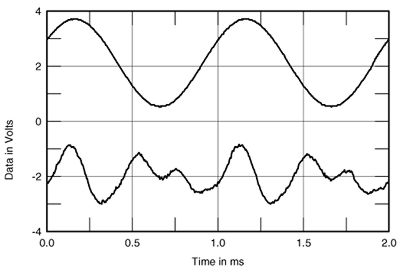| Columns Retired Columns & Blogs |
VTL IT-85 integrated amplifier Measurements page 2
Fig.4 plots the VTL's small-signal THD+noise percentage against frequency; the level of distortion rises both at the frequency extremes and into loads below 4 ohms. The content of that distortion is mainly low-order harmonics (fig.5), but with low frequencies reproduced at high levels (fig.6), the third and fifth harmonics are the highest in level, which might make the amplifier sound a little forward-balanced. Even just below clipping, the level of intermodulation distortion (fig.7) was acceptably low, the difference product just reaching the -60dB line (0.1%).

Fig.4 VTL IT-85, THD+noise (%) vs frequency at (from top to bottom at 4kHz): 4W into 2 ohms, 2.83V into simulated loudspeaker load, 2W into 4 ohms, and 1W into 8 ohms.

Fig.5 VTL IT-85, 1kHz waveform at 10W into 8 ohms (top), distortion and noise waveform with fundamental notched out (bottom, not to scale).

Fig.6 VTL IT-85, spectrum of 50Hz sinewave, DC-1kHz, at 50W into 8 ohms (linear frequency scale).

Fig.7 VTL IT-85, HF intermodulation spectrum, DC-24kHz, 19+20kHz at 30W into 8 ohms (linear frequency scale).
When it came to continuous power output (fig.8), the VTL, as expected, was happier into higher impedances, reaching the 1% THD+N clipping point into 8 ohms at 60W, as specified (17.8dBW), with less power available into 4 or 2 ohms unless the defined clipping point was relaxed to 3% THD. I used the Miller Audio Research Amplifier Profiler to test the IT-85's output power with a low-duty-cycle 1kHz toneburst, which more closely approximates a typical musical signal. With just one channel driven (fig.9), considerably more power was available at the 1% THD point (magenta line): 78.3W into 8 ohms (18.9dBW, black trace) and 123W into 4 ohms (17.9dBW, red). But the distortion rose quickly enough to limit the 2 ohm power to 15W (blue) and the 1 ohm power to just 3.5W (green).

Fig.8 VTL IT-85, distortion (%) vs continuous output power into (from bottom to top at 10W): 8 ohms, 4 ohms, and 2 ohms.

Fig.9 VTL IT-85, distortion (%) vs 1kHz burst output power into 8 ohms (black trace), 4 ohms (red), 2 ohms (blue), and 1 ohm (green).
This is a good set of measurements for a conventional push-pull tube design. As long as the matching loudspeakers don't drop below 4 ohms in frequency regions where the music has much power, the VTL IT-85 should deliver good, low-distortion performance.—John Atkinson
- Log in or register to post comments




































